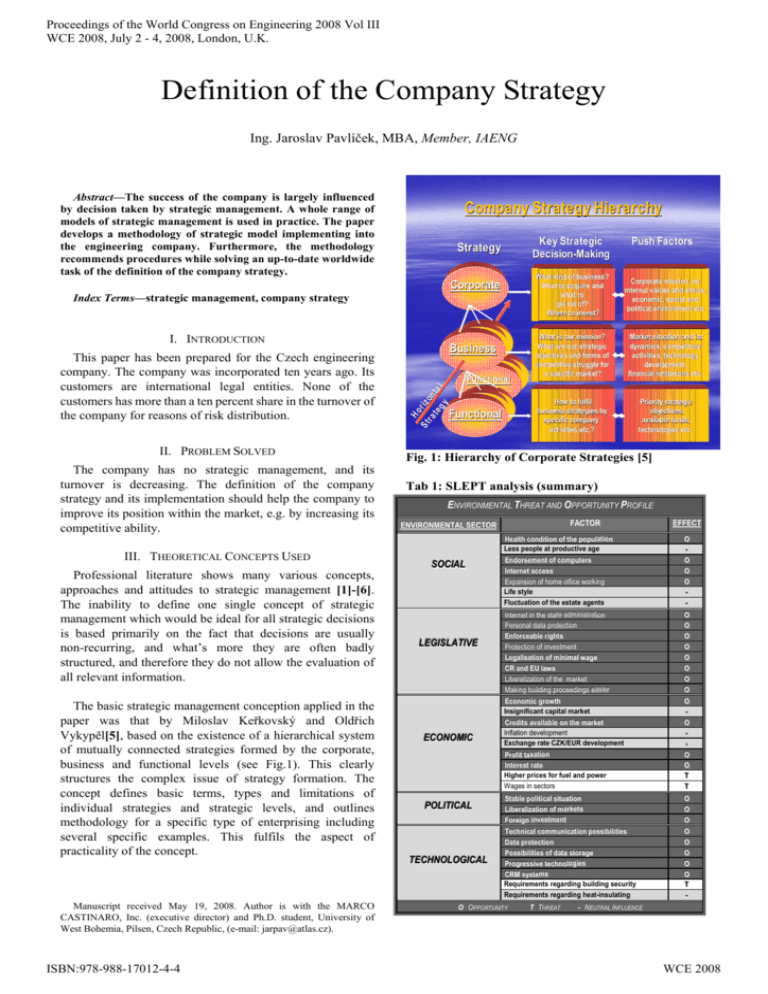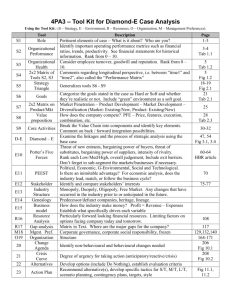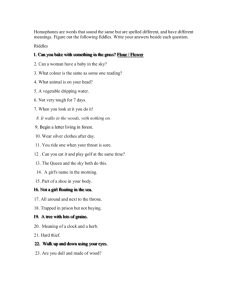Definition of the Company Strategy
advertisement

Proceedings of the World Congress on Engineering 2008 Vol III WCE 2008, July 2 - 4, 2008, London, U.K. Definition of the Company Strategy Ing. Jaroslav Pavlíček, MBA, Member, IAENG Abstract—The success of the company is largely influenced by decision taken by strategic management. A whole range of models of strategic management is used in practice. The paper develops a methodology of strategic model implementing into the engineering company. Furthermore, the methodology recommends procedures while solving an up-to-date worldwide task of the definition of the company strategy. Company Strategy Hierarchy Key Strategic DecisionDecision-Making Strategy Corporate Index Terms—strategic management, company strategy I. INTRODUCTION Ho ra r iz o te nta l gy Functional Functional St This paper has been prepared for the Czech engineering company. The company was incorporated ten years ago. Its customers are international legal entities. None of the customers has more than a ten percent share in the turnover of the company for reasons of risk distribution. Business II. PROBLEM SOLVED The company has no strategic management, and its turnover is decreasing. The definition of the company strategy and its implementation should help the company to improve its position within the market, e.g. by increasing its competitive ability. III. THEORETICAL CONCEPTS USED Professional literature shows many various concepts, approaches and attitudes to strategic management [1]-[6]. The inability to define one single concept of strategic management which would be ideal for all strategic decisions is based primarily on the fact that decisions are usually non-recurring, and what’s more they are often badly structured, and therefore they do not allow the evaluation of all relevant information. The basic strategic management conception applied in the paper was that by Miloslav Keřkovský and Oldřich Vykypěl[5], based on the existence of a hierarchical system of mutually connected strategies formed by the corporate, business and functional levels (see Fig.1). This clearly structures the complex issue of strategy formation. The concept defines basic terms, types and limitations of individual strategies and strategic levels, and outlines methodology for a specific type of enterprising including several specific examples. This fulfils the aspect of practicality of the concept. Manuscript received May 19, 2008. Author is with the MARCO CASTINARO, Inc. (executive director) and Ph.D. student, University of West Bohemia, Pilsen, Czech Republic, (e-mail: jarpav@atlas.cz). ISBN:978-988-17012-4-4 Push Factors What kind of business? What to acquire and what to get rid of? Where to invest? Corporate mission, its internal internal values and ethics, economic, social and political environment etc. What is our mission? What are our strategic objectives and forms of competiti competitive struggle for a specific market? Market situation and its dynamics, competitors’ competitors’ activities, technology development, financial limitations etc. How to ful fulfil business strategies by specific company activities etc.? Priority strategic objectives, available funds, technologies etc. Fig. 1: Hierarchy of Corporate Strategies [5] Tab 1: SLEPT analysis (summary) EENNVVIIRROONNMMEENNTTAALL TTHHRREEAATT AANNDD O OPPPPOORRTTUUNNIITTYY PPRROOFFIILLEE FFAACCTTO ORR EENNVVIIRROONNM MEENNTTAALL SSEECCTTO ORR SSO OCCIIAALL LLEEG GIISSLLAATTIIVVEE EECCO ONNO OM MIICC PPO OLLIITTIICCAALL TTEECCHHNNO OLLO OG GIICCAALL EEFFFFEECCTT HHeeaalltthh ccoonnddiittiioonn ooff tthhee ppooppuullaattiioonn Less people at productive age EEnnddoorrsseem mppuutteerrss meenntt ooff ccoom IInntteerrnneett aacccceessss EExxppaannssiioonn ooff hhoom mee oofffiiccee wwoorrkkiinngg Life style Fluctuation of the estate agents OO -OO OO OO --- IInntteerrnneett iinn tthhee ssttaattee aaddm miinniissttrraattiioonn PPeerrssoonnaall ddaattaa pprrootteeccttiioonn EEnnffoorrcceeaabbllee rriigghhttss PPrrootteeccttiioonn ooff iinnvveessttm meenntt LLeeggaalliissaattiioonn ooff m maall wwaaggee miinniim CCRR aanndd EEUU llaawwss LLiibbeerraalliizzaattiioonn ooff tthhee m maarrkkeett M Maakkiinngg bbuuiillddiinngg pprroocceeeeddiinnggss eeaassiieerr OO OO OO OO OO OO OO OO EEccoonnoom miicc ggrroowwtthh Insignificant capital market CCrreeddiittss aavvaaiillaabbllee oonn tthhee m maarrkkeett Inflation development Exchange rate CZK/EUR development PPrrooffiitt ttaaxxaattiioonn IInntteerreesstt rraattee Higher prices for fuel and power Wages in sectors OO -OO --OO OO TT TT SSttaabbllee ppoolliittiiccaall ssiittuuaattiioonn LLiibbeerraalliizzaattiioonn ooff m maarrkkeettss FFoorreeiiggnn iinnvveessttm meenntt OO OO OO TTeecchhnniiccaall ccoom muunniiccaattiioonn ppoossssiibbiilliittiieess mm DDaattaa pprrootteeccttiioonn PPoossssiibbiilliittiieess ooff ddaattaa ssttoorraaggee PPrrooggrreessssiivvee tteecchhnnoollooggiieess CCRRM mss M ssyysstteem Requirements regarding building security Requirements regarding heat-insulating OO OO OO OO OO TT -- OO OOPPPPOORRTTUUNNIITTYY TT TTHHRREEAATT -- NNEEUUTTRRAALLIINNFFLLUUEENNCCEE WCE 2008 Proceedings of the World Congress on Engineering 2008 Vol III WCE 2008, July 2 - 4, 2008, London, U.K. The definition of the strategy runs from top to bottom so that the superior level determines the basic strategic objectives for its subordinate levels. The subordinate levels then develop objectives into particular details on their level. This also secures feedback from bottom to top and verifies the objectivity of the strategic objectives determined on superior levels. The company's external environment will be analysed using General Environment Analysis (SLEPT) [5] which will show any potential threats and opportunities that can influence decision about the corporate strategy. SLEPT analysis is limited only to the relevant factors in terms of making decisions about the corporate strategy (see Tab.1). To analyse the decisive factors that are determining for the given market, we will use Porter's five-factor model of competitive environment[5], [6] that contains the analysis of the following five factors: bargaining power of buyers, bargaining power of suppliers, threat of entry of new competitors, threat of substitutes and competitive rivalry (see Tab. 2). Tab 2: Factor evaluation with the method for objectifying Porter's analysis Stakeholders Expectations Owners - company turnover and goodwill growth Employees Trade union Customers Suppliers Government - securing the work position - wage and qualification Increase (not founded) - lower prices - better services - higher awareness - increased prices - maximum tax collection - employing more people Year Year 2008 2013 4.8 5.4 6.5 6.0 5.3 4.8 Bargaining power of buyers Bargaining power of suppliers Threat of entry of new competitors Threat of substitutes 2.8 Competitive rivalry in the 5.1 industry Factors evaluation interval: < 1 ; 9 > min = 1point max = 9points 3.0 5.3 Objectives and priorities of satisfying Power / the information needs priority Management - long-term prosperity - company expansion - company team stabilisation - information about goodwill - information about company's economic activity - information about strategic aims - information support of decision-making - business activities promotion - introduction of controlling - information about company's economic activity (not founded) - introduction of controlling - customer needs surveys - information about company development - information about solvency - information about company's economic activity - information about company 1 2 4 7 3 5 6 Stakeholder priority objectification Priority Porter's factors Tab 3: Results of the analysis of stakeholders' expectations and information needs 100,00% 90,00% 80,00% 70,00% 60,00% 50,00% 40,00% 30,00% 20,00% 10,00% 0,00% Priority evaluation Owners Employees Management Customers Trade union Government Suppliers Stakeholders The most often used company environment classification as shown in [3] defines the crucial company stakeholders. For a strategy to be successful it should not be at variance with the crucial stakeholders' interests, i.e. it should be formulated in view of their objectives, interest, information needs and strength. To determine the priorities/power of the individual stakeholders a point system has been used (see Tab. 3, Figure 2). In the analysis of the internal company environment we will identify and analyse ´7P´ components (Product, Price, Place, Promotion, People, Process and Planning) that will be subsequently included in the content definition of the proposed strategy. ISBN:978-988-17012-4-4 Fig 2: Comparison of priorities of the company stakeholders All relevant factors identified the analyses above will now be arranged according to their impact. In order to make rational conclusion based on the analysis, we will have to carry out synthesis of the most important factors in a final SWOT table (see Tab. 4) considering the fact that some of the factors have similar consequences, and some are less important within the group than factors with the same effects. The result will not be overwhelmed by too many factors with similar effects or less importance than several dominant factors. Too many factors also make it more difficult to propose measures which would improve the situation in the company. WCE 2008 Proceedings of the World Congress on Engineering 2008 Vol III WCE 2008, July 2 - 4, 2008, London, U.K. Tab 4: SWOT analysis S List of Strengths S5 - Differentiated services S6 - Advantageous location of properties S21 - High quality S28 - Finance for fixed assets development S30 - Viable opportunities for expanding the company S32 - Stabilized team of experienced employees S33 - High loyalty employee to the company O List of Opportunities O1 - Management support of company expansion O13 - Making building proceedings easier O14 - Economic growth O15 - Credits available on the market O16 - Profit taxation O26 - Low threat of substitutes O27 - Invoicing customers for their energy Consumption W List of Weaknesses W5 - Unsatisfied demands due to insufficient capacities W6 - Missing development of new services W8 - No marketing department W10 - No flat organisational structure W13 - Missing systems of work evaluation W16 - Non-conceptual educational system And staff development T List of Threats T1 - Decrease of prices of company services T2 - Higher prices for fuel and power T3 - Wages in sector T4 - Requirements regarding building security T5 - Significant bargaining power of suppliers The basic objective of this company strategy includes the sequential combination strategy. It is a combined strategy typical of companies in a period of changing the life cycle of the supplied services and markets. The company is unable to meet the customer demand for outsourcing services, which is caused by the growth of both services and markets. From the point of view of time, the sequential character means that this year the company follows the strategy of stability in order to aggregate finance, and next year it will change to expansion. V. IMPLEMENTATION PROCESS The proposed solution will help company to implement its objectives in the field of strategy. The implementation process can be divided into two parts. The first, managerial part is based on the abilities of the implementation manager and his/her vision, company activation and support of the prepared proposals. The second, administrative part is based on the abilities of company to adopt and further develop the started process. REFERENCES [1] [2] IV. DEFINITION OF THE COMPANY STRATEGY As a form of competitive fight, the company has chosen the strategy of differentiation focus, by means of which it competes primarily with the specific character of its services. The chosen generic strategy of differentiation focus as shown in fig 3 is given preference thanks to the fact that competition in the given industry is not as keen, new entries of rivals into the industry are difficult mainly as far as investments are concerned, there is a small threat of substitutes and high customer loyalty. Differentiation is achieved by means of the supply, where the company provides its customers with a higher value for a price comparable to rivals. [3] [4] [5] [6] De Wit, B., Meyer, R., Strategy (Process, Content, Context). New York, West Publishing Company, 1995 Earl, M. J.,Management Strategies for Information Technology. Prentice Hall,1989 Houlden, B., Understanding Company Strategy. Basil Blackwell, 1990,p. 74 Johnson,G., Scholes,K., Exploring Corporate Strategy. 3rd ed. New York: Prentice Hall, 1993 Keřkovský,M., Vykypěl, O., Strategické řízení. Teorie pro praxi. 1. vydání. Praha: C.H.Beck,2002 Porter, M., E., Competitive Strategy. Macmillan, New York, 1985 Wide COST LEADERSHIP DIFFERENTIATION COST FOCUS DIFFERENTIATION GOAL FOCUS Narrow Costs Differentiated Services FOCUS Fig 3: Generic strategy according to Porter [6] ISBN:978-988-17012-4-4 WCE 2008






